- About MAA
- Membership
- MAA Publications
- Periodicals
- Blogs
- MAA Book Series
- MAA Press (an imprint of the AMS)
- MAA Notes
- MAA Reviews
- Mathematical Communication
- Information for Libraries
- Author Resources
- Advertise with MAA
- Meetings
- Competitions
- Programs
- Communities
- MAA Sections
- SIGMAA
- MAA Connect
- Students
- MAA Awards
- Awards Booklets
- Writing Awards
- Teaching Awards
- Service Awards
- Research Awards
- Lecture Awards
- Putnam Competition Individual and Team Winners
- D. E. Shaw Group AMC 8 Awards & Certificates
- Maryam Mirzakhani AMC 10 A Awards & Certificates
- Two Sigma AMC 10 B Awards & Certificates
- Jane Street AMC 12 A Awards & Certificates
- Akamai AMC 12 B Awards & Certificates
- High School Teachers
- News
You are here
A Magic Timepiece Influenced By Martin Gardner
October 2007
Generalizations of the kind of magic bracelet considered last time around in Card Colm are considered below, with most attention being paid to one magic timepiece in particular. We start with a two-deck effect based on that, and discuss various setup and presentational options after we have explained where this clock comes from.
Volunteer Four Hours (The Big Deal)
Remove an Ace, 2, 3, ..., 10, Jack and Queen from a blue-backed deck of cards, and deal them face down into a circle, representing the hours of a crazy clock.
Remove a red-backed deck from its case, and casually shuffle it, as you announce, "I need a volunteer." Once somebody steps forward, say, "Actually, I need you to volunteer four hours. Is that okay?"
As a look of alarm spreads across the volunteer's face, add, "In theory, you are supposed to do four hours of volunteer work, but don't worry, this will only take a few minutes, and I promise there's no heavy lifting involved."
Continue, "Please mentally select a four-hour shift: decide on four adjacent cards from the clock of cards displayed here. These will determine the four hours you're volunteering for. Don't give me any hint as to which cards you've selected. Each card has a number on it, which will reveal how many heavy boxes you're supposed to lift during that hour. Actually, the only lifting you'll have to do involves a corresponding number of cards from this red-backed deck." As you say those words, put the red-backed deck back in its case.
Take a sealed prediction envelop out of your pocket, and say, "Earlier on, I made a prediction about the outcome of your volunteer work." Place the sealed envelop on the table, and put the red card case top of it.
Ask the volunteer to indicate which four adjacent blue-backed cards they mentally selected. Gather up the other eight cards and set them aside. Have the four selected cards turned over and the values summed, with the usual reminder that Jack is 11, Queen 12, etc..
Once the total is reported---let's suppose it's 26---pick up the red card case, and take out the cards. Hand them to the volunteer and say, "Here comes that heavy lifting you've been worrying about. I want you to lift off twenty-six cards. You can do them one at a time to make it easier. That way the count will be perfect too."
The volunteer lifts off one card at a time, setting them all aside until the 26th card is lifted off. "What is the last card you lifted?" you ask. The volunteer reveals the identity of that card. Have your envelop opened and your prediction read out; it matches the red-backed card arrived at. The cards may all be inspected.
The Subtler Decrees
There are two main secrets here: one blue, one red. You may wish to think it over a bit before reading on.
The big deal for the blue-backed cards is that the circle is arranged so that the sum of any four adjacent values is always 25, 26 or 27. The origins and development of this curious possibility take up most of what's below.
By gathering up the remaining eight cards before the prediction revelation, you distroy all evidence of a carefully arranged clock. One way to get the cards in the desired order is to first stack the blue-backed deck so that required cards can be pulled out as needed while scanning the card faces. Other methods are discussed later.
The red secret follows along more well-known lines: on the prediction slip you write the name of the 26th card from the top of the red-backed deck. (Back in the December 2005's Card Colm, we also dwelt a little on advance knowledge the 26th card in a deck.) Some shuffling can be done if you are careful not to disturb the middle of the deck.
If 26 is the total found, then have the 26th card lifted looked at, exactly as indicated earlier. If 25 is the total found, have that many cards lifted, and the next card looked at. If 27 is forced, don't worry: turn over the red card case before taking the deck out again, so that it emerges face up. Have 27 cards lifted off, counting from the face, and have the last one looked at.
Twelve Rook Run
The crazy clock required for the above effect is a generalization of the kind of magic bracelet considered last time around in Card Colm. There, we looked at bracelets for which triple sums of three adjacent beads yielded a total which alternated n and n+1 for some n. It turned out that basically these must have 6 beads and be of the form:
(with the end looped back to the start) for some a and b.
This time, we need to focus on bracelets for which quadruple sums of adjacent beads cycle through the values n - 1, n, n + 1, for some n . An example would be the hours on the clock below, for which n = 26.
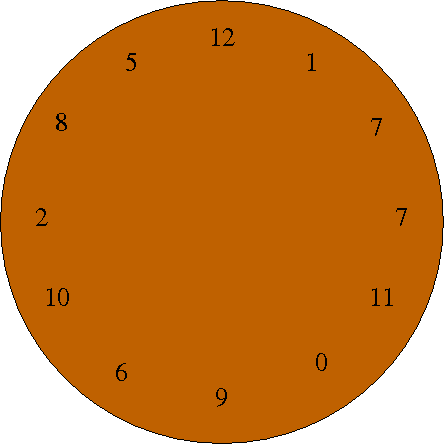
Note that this decomposes into four special equilateral triangles, namely {0, 1, 2}, {5, 6, 7}, {7, 8, 9} and {10, 11, 12}.
In general, the values n - 1, n, n + 1 may repeat, in some fixed order, in any of 3! = 6 possible ways. Above, it's 26, 25, 27 if we read clockwise, starting with the 1, 7, 7, 11, then moving on to 7, 7, 11, 0, etc. Totals of 25, 26, 27 in that order may be obtained by reading anti-clockwise instead, starting with 7, 1, 12, 5 for instance.
It's not hard to show that magic bracelets which force consecutive quadruple sums n - 1, n, n + 1 are basically of length 12. Without loss of generality, bearing in mind invariance under reflections and rotations, they are of the form:
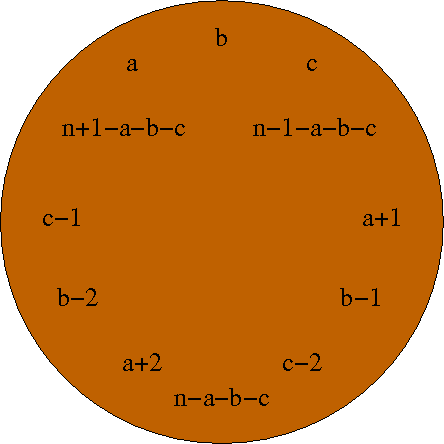
for some a, b and c. Any a, b, c work, so there is a three parameter family of possibilities. Just as for the earlier example, these all decompose into four equilateral triangles of consecutive triads (more on this in due course). A similar observation---suitably scaled down---holds for the bracelets of six beads considered last time around. (Long live the rarely acknowledged regular n-gon for n = 2! Yes, that's two factorial.)
If we use cards, whose values range from 1 (Ace) to 13 (King), there are only finitely many such bracelets, and the same holds if we follow the convention, suggested in earlier 2007 Card Colms, that red cards correspond to negative values, and Jokers represent zeros. We leave it to keen readers to tabulate all possible examples using cards.
A positive example with n = 26 is obtained when a, b, c = 1, 7, 8, or, equivalently, by connecting the ends of: [1 7 8 9 3 6 7 11 2 5 9 10].
In both of the above examples, no beads are negative or exceed 12, and some values are repeated. Two questions naturally arise:
-
Do positive bracelets without repeats exist?
-
Are there any positive bracelets using precisely 1, 2, 3, ...., 11, 12?
Of course, a positive answer to the second question also yields a positive answer to the first. If such bracelets exist, then the sum of all twelve beads is 1 + 2 + 3 + .... + 11 + 12 = (12x13)/2 = 78. It can be checked, since 3 and 4 are relatively prime, that this total must also equal (n - 1) + n + (n + 1) = 3n. Hence, n = 26, as in the earlier examples.
What we seek is very special rearrangements (permutations) of the twelve hours on a traditional clock. Happily, these beauties exist, and one such is shown below; it's [1 5 9 10 2 6 7 11 3 4 8 12] looped end to end. This is exactly what we need for the two-deck effect first considered above.
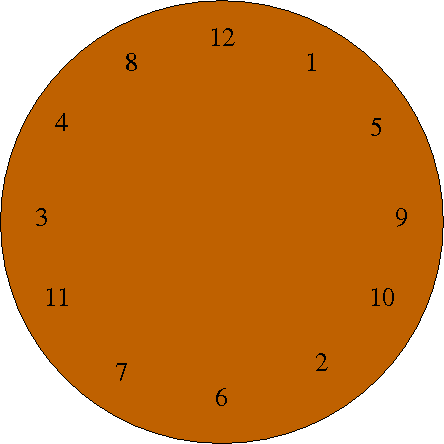
A Magic Timepiece Influenced By Martin Gardner (Celebrating His 93rd Birthday Incidentally)
The big deal here is that:
Here's one way to view the desired order [1 5 9 10 2 6 7 11 3 4 8 12]: start with 1 in the usual position on a clockface, and then move clockwise in steps of size 4, 4, 1, repeated until you return to the 1, dealing out 2, 3, 4, ...., 12 in the usual order into these hour positions as you go along. (Note that 21 October is Martin Gardner's birthday, and 212 = 441. Also, 122 = 144 and 441- 114 = 297, a BIG coincidence in our estimation.)
Some questions arise:
-
Can cards be cajoled into this order without arousing suspicion?
-
How can we take advantage of this departure from regular timekeeping?
-
Is there an easy way to remember this configuration? A catchy mnemonic would really help.
We're already provided one answer to the second question. We leave it to alert readers to see if they can answer the third one themselves.
As for the first question, there are several possibilities. The desired order can be obtained from an ordinary clock by switching pairs of diametrically opposite hours: switch 3 with 9 and then 4 with 10, as well as switching 8 with 11 and then 2 with 5. While this lacks elegance, that's not such a bad thing: e.g., you can do it casually and sloppily to a clock of cards in the usual order, "to introduce chaos."
There is a suit-specific sequence worth considering, which uses the standard CHaSeD order ♣, ♥, ♠, ♦, and ties in with the equilateral triangle decomposition already noted. Use the cards:
A♣, 5♥, 9♠, 10♦, 2♣, 6♥, 7♠, J♦, 3♣, 4♥, 8♠, Q♦
for the clock face.
One advantage of this arrangement is its relationship with a more obvious ordering of the cards. If cards in that order are dealt into four piles, from left to right, not only are the piles separated by suit, the first and last ones consist of the A♣, 2♣, 3♣ and 10♦, J♦, Q♦ respectively, in that order. The middle two piles consist of the 5♥, 6♥, 4♥, and 9♠, 7♠, 8♠, respectively, in those orders. Conversely, if you start with the four "canonical" piles: A♣, 2♣, 3♣; 4♥, 5♥, 6♥; 7♠, 8♠, 9♠; 10♦, J♦, Q♦, you can find an excuse to hold up the cards in the middle two piles and surreptitiously alter the position of just two cards so that, when the piles are collected---the ones on the right going on top of the ones on the left---and the cards dealt out again (face down) into three piles of four cards, and those piles are reassembled as above, the desired order A♣, 5♥, 9♠, 10♦, 2♣, 6♥, 7♠, J♦, 3♣, 4♥, 8♠, Q♦ results.
(The twelve cards suggested above could be supplemented with K♣, followed by three similar thirteen card stacks, starting with A♥ , 5♠, 9♦, ..., to yield a "Si Stebbens" like stack of the whole deck. This allows for a single Gilbreath shuffle, before or after which the Kings can be removed. The top twelve cards may placed in a circle, in the appropriate order, and Volunteer Four Hours performed.)
Book forces are an alternative to the card predictions already considered. Note that page 26 of Martin Gardner's classic book Mathematics, Magic and Mystery (Dover, 1956) begins with the words, "Pick up either pile" (these words can be worked into what follows with a little imagination). If 26 is forced, you are all set. If 27 is forced, say "Open the book to that page. Actually, look at the very first words on the facing page...." If 25 is forced, say, "This is the page you selected. I'm getting an impression of some words... I do believe they are burning through from the following page. Please turn the page, I'll see if I can deduce the first words on that page."
Another way to handle the triple ambiguity implicit in the quadruple sums is to have a book on standby for the n + 1 case, but use a packet of cards as before if one of n - 1 or n is determined. In this situation, you do not announce in advance, "I have written a prediction here"---unless you can come up with one which covers both cases: the words on a page or the name of a particular card. The words "It is the Ace of Spades" conveniently start page 24 of Mathematics, Magic and Mystery!
Perfect Timekeeping
Unlike in the case of positive bracelets of six beads with minimal alternating triple sums (necessarily 10 and 11), the bracelet above with three cycling consecutive quadruple sums of 25, 26 and 27 is far from unique. It may be verified that there are five additional such arrangements of 1, 2, 3, ...., 12. That's six possibilities in total: a perfect situation.
One of these other examples is [1 11 9 4 2 12 7 5 3 10 8 6], which may be obtained starting at the 1 and then moving clockwise in steps which are all of size 6 larger than the steps above above, namely, steps of size 10, 10, 7, 10, 10, 7, etc.. Equivalently, one can start at the 12 and move anti-clockwise in steps of size 2, 2, 5, 2, 2, 5, etc..
Generalizing Around the Clock
What about bracelets for which quintuple sums of adjacent beads cycle through the values n - 1, n, n + 1, n + 2, for some n? An example would be the hours on the crazy clock below, for which n = 31. Since several values are used more than four times, this one is of little use if we are restricted to a single deck of cards.
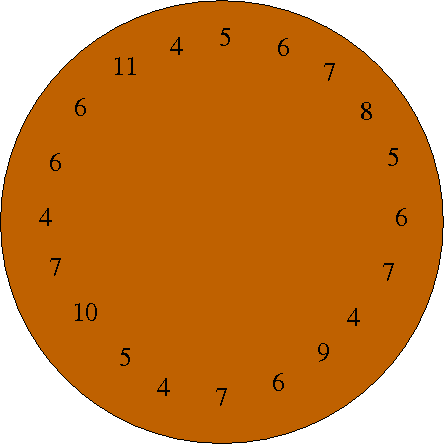
Like the others of its ilk, this one decomposes into five squares of consecutive values.
Let's focus on the possible sums. In general, the values n - 1, n, n + 1, n + 2 may repeat, in some fixed order, in any of 4! = 24 possible ways. Since reflections and rotations yield the same bracelets, there are actually only 3!/2 = 3 distinct orders (the so-called free circular permutations of four objects). Above, it's 30, 31, 32, 33 reading clockwise (starting with the 4, 5, 6, 7). The only other possible orders that need to be considered are: 30, 31, 33, 32 and 30, 32, 31, 33.
It's not hard to show that magic bracelets which force consecutive quintuple sums n - 1, n, n + 1, n + 2 are basically of length 20. Finding a formula for their general form---and similarly for the other two possible orders of the quintuple sums---is left as an exercise. Four parameter families are found in all cases.
It goes without saying that bracelets using precisely 1, 2, 3, ...., 19, 20 would be particularly pleasing. The bead total would then be 1 + 2 + 3 + .... + 20 = (20x21)/2 = 210. It can be seen, since 4 and 5 are relatively prime, that this total must also equal (n - 1) + n + (n + 1) + (n + 2) = 4n + 2 so that n must be 52.
Such bracelets amount to very special rearrangements (permutations) of a twenty hour clock. Happily, these beauties also exist, and one such is shown below. It's [1 6 11 16 17 2 7 12 13 18 3 8 9 14 19 4 5 10 15 20] looped end to end, and may be obtained by starting with 1 on a circle with 1--20 in order, like on a clock, and then moving clockwise in steps of size 5, 5, 5, 1, repeating until you return to the 1.
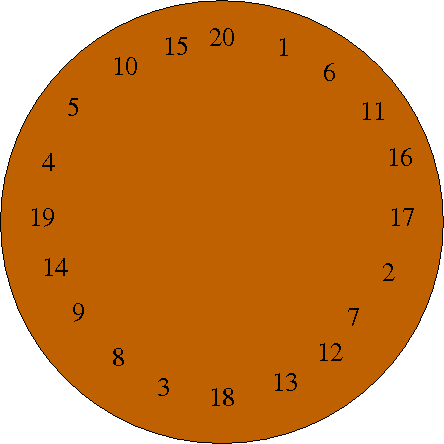
Adding any five adjacent hour values always yields 51, 52, 53 or 54. The kind of card prediction suggested earlier for twelve hour clocks with triple ambiguity of quadruple sums can be adapted to work for the quadruple ambiguity of quintuple sums here. The downside is that a deck of cards is too small to accommodate such large numbers. One possibility is to try to shift everything to the left and work with negative as well as positive numbers, where red cards and Jokers represent negatives and zero respectively; we leave it to the interested reader to follow up on this.
Colm Mulcahy (colm@spelman.edu) has been in the department of mathematics at Spelman College since 1988. He wishes to thank Neil Calkin at Clemson for contributing the clockface images. It seems appropriate that they be displayed on a tan background, since the cosines and sines used for plotting circles are also the background needed for studying tan. "Subtler Decrees" is an anagram of "Red/Black Secret." "Twelve Rook Run" is an anagram of "Volunteer Work." For more on mathematical card tricks, including a guide to topics explored in previous Card Colms, see http://www5.spelman.edu/~colm/cards.html.




